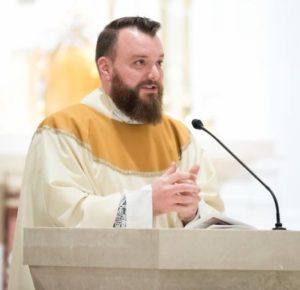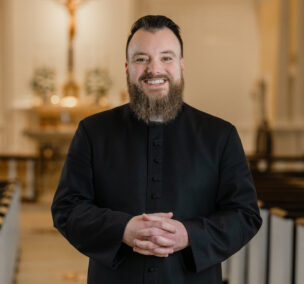 Dear Brothers and Sisters in Christ,
Dear Brothers and Sisters in Christ,
Lex orandi, lex credendi, lex vivendi, is a Latin phrase meaning (roughly) “the law of prayer is the law of faith, is the law of living.” The way we pray teaches us what we believe about God, which in turn teaches us how we are to live every day. This order of things puts us in the right frame of mind: by encountering the living God, we learn who He is and our relationship with Him shows us how our lives must be transformed by this grace-filled encounter. This season has been a constant reminder to turn to the Lord, to let that orientation toward God urge us into prayer. This prayer in turn has taught us who God is, to recognize the truth of Jesus Christ and His Gospel, to confess that He is Lord and Messiah, to cry out with the people of Jerusalem as He rides into the holy city “Hosanna to the Son of David!” Our renewed belief transforms how we live, making virtue the great desire of our hearts. So often, though, we reverse the order. In our world, it is easy to let our actions, the lex vivendi, dictate what we believe, the lex credendi, which in turn dictates how we pray and relate to God, the lex orandi. When this happens, we create God in our own image and justify ourselves even when our choices conflict with the Good News of the Gospel. How easily we shift with the people of Jerusalem from “Hosanna to the Son of David” to “Crucify him, crucify him!” The events of Holy Week that we participate in now open our eyes to see more clearly how we invert the order in sin, but also provide for us the remedy and teach us to reorder, to reorient our lives and so look with joyful anticipation to the east, standing ad orientem awaiting our Lord’s triumphant resurrection from the tomb.
Lent is a time to turn once again to the Lord. The Church taught at Vatican II that in the Mass, the Eucharistic sacrificial liturgy, we find the source and summit of our faith. All our prayer, fasting, and almsgiving, the entirety of the Christian life flows from and returns to the Mass, the privileged place for our encounter with God. If we pay attention to the Mass, we will see how the prayer of the Church offered at the altar is filled with the truths of our faith. In the procession to the altar, we imitate the procession of Jesus into Jerusalem, the procession that would take Him to the altar of the Cross on Calvary. At the altar, the priest kisses the altar, embracing the symbol of Christ, the symbol of the Cross, just as on Good Friday we reverence the Cross as the instrument of our salvation. With the Sign of the Cross, the community binds unto itself, to borrow a phrase from St. Patrick, the strong name of the Trinity. We believe in one God who is Father, Son, and Holy Spirit. The communal confession of sin places us squarely in the successive line of God’s people from Adam and Eve to Israel, to the Apostles, to the Church throughout the ages: a line full of sinners who hope for redemption, who confidently approach God to ask for mercy. The prayer of the Mass then leads us to a reflection on Scripture which teaches us the story of God’s loving plan for the salvation of his creation. From there we proceed to the altar, where the priest stands on behalf of the whole community to offer to God the gift of the Eucharist. The whole Christian people gathered now faces toward the Lord in humble supplication and prayer, in a common act of thanksgiving, a united act of worship. From the Lord we then receive the gift of Communion and are invited to approach the Holy of Holies to encounter Him. We are brought into the intimacy of the Last Supper and entrusted with the greatest gift of God to man, the Eucharist. Having prayed and been confirmed in faith, we are then sent out to the world to bring the Gospel to everyone, by our actions to transform the world in the image of God, and bring the world to recognize and experience the Light of Christ.
Lex orandi, lex credendi, lex vivendi. The Mass gives us a lesson in prayer, faith, and right living, par excellence. However, those vital lessons and their lived consequences can be lost if Mass, in its practice, fails to show in outward sign the inward reality being communicated. If Mass is celebrated as something horizontal – all mystery removed, just a gathering of friends for a joyful meal – if homilies are even more horizontal – just platitudes, self-help tips, “therapeutic moralistic deism” as a popular phrase has it – then, lex orandi, lex credendi, we come to believe that the Catholic faith is far more horizontal. The gradual sense that going to Mass is not important has crept in because we have prayed Mass as if it were not important. The logical follow-up is that belief in the Gospel is not important, which means there is no reason to live according to the Gospel. What happens when Christians stop living as though the teachings of Jesus really matter in their everyday life?
The years following the Second Vatican Council have been marked by a decline in Catholic culture. Rather than the robust culture the faith has always fostered, full of art, music, community, theology, charity, beauty, architecture, service, and philosophy, we have seen Catholic culture replaced by cheap stereotypes and tropes. We have seen some elements of our culture, especially architectural treasures in churches, literally destroyed. This leaves Catholics with little cultural cache when interacting with a pluralistic society. One with no culture to call their own cannot function in such a society and instead is forced to adopt the patina of acceptable social culture. Among the last shreds of genuinely, distinctly Catholic culture are the Mass and the season of Lent. These forty days of Lent have reminded us to practice prayer, fasting, and almsgiving, and in so doing, to reorient our lives to the things of God rather than the things of this world.
Holy Week marks the holiest days of the year for Catholics. This is a time for unique liturgical and cultural expressions of faith. From the palms we take home from Mass today to the commemoration of the Lord’s Supper on Holy Thursday, to our overnight vigil with Jesus at the altars of repose on Holy Thursday night, to our intensive fasting on Good Friday, to our bonfire to mark the Resurrection, we Catholics have an opportunity to pray, and in prayer, to understand the goodness of God more completely and to allow that truth to influence how we live in this world. While Holy Week highlights what we have, every single Mass can do the same. Last week I suggested the possibility of the priest celebrating Mass facing the altar with the whole assembled congregation, facing toward the Lord with them, a common orientation as he carries out the task of interceding before God on their behalf. This posture emphasizes the truth that Mass is not primarily about us being together to celebrate ourselves, but rather about us being together before the Lord for the sake of worship. It reminds the priest and the people alike of the mystery they stand before, of the universal call to holiness which the Second Vatican Council reminded us of so beautifully in Lumen Gentium. As a pilgrim people journeying toward the Lord, priests and laity come together to the altar. Their common orientation to the liturgical east is different. It stands out against all the other things we might do in a given day. It reminds us that there is more than this world. In a cultural environment often hostile to the Catholic faith, Mass celebrated with clergy and laity united in a common posture of prayer shows us visibly that our Catholic faith can and should contribute to the culture-at-large. Ad orientem worship as an interior disposition and a physically expressed reality makes the command to be salt for the earth and light for the world echo in our hearts. As we turn east this week, anticipating the promise of the Resurrection, may the dawn from on high, Jesus Christ, enlighten our minds and hearts by what we celebrate, so that the law of prayer may truly become the law of faith, and thus be so beautifully integrated that it becomes the law of our lives.
Peace,

Fr. Sam


